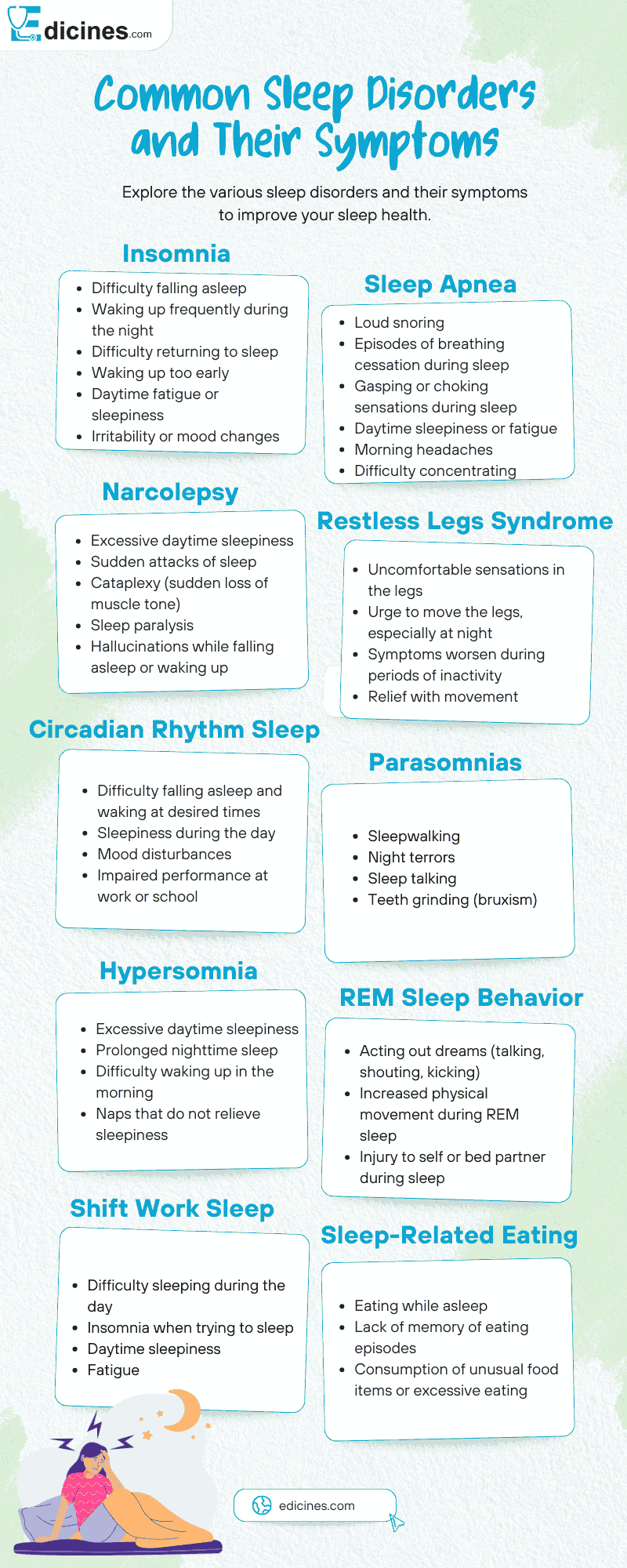This article will discuss common sleep disorders and treatment options to improve sleep quality. Sleep hygiene is one of the most important factors which contribute to an individual’s overall health. It promotes tissue repair in the body, assists in cognitive functioning, and is important for the development of an immune system. Unfortunately, not everyone can undergo restorative sleep due to the prevalence of sleep disorders.
As is the case with several untreated problems, these ‘sleeping disorders’ can turn out to more advanced stages with chronic complications including excessive daytime sleepiness, depression, heart failure, etc. Disrupting the sleep cycle is an issue that is faced globally by millions on a daily basis affecting daily activities and overall health.
What are Sleep Disorders?
Sleep disorders refer to a range of conditions that disrupt sleeping patterns, affecting both the quantity and quality of sleep. Health states such as these may lead to one’s incapacity to perform activities effectively during the day since both the mental and physical aspects of one’s health may be greatly affected.
One can, however, learn to appreciate the difference between issues related to sleep that may be present for a short duration such as sleeplessness from stress and more threatening conditions that persist for a long time and often need treatment.
Temporary Sleep Issues
Such short-lived problems may also be due to stress travel or even sickness where the pattern is changed abruptly. Such problems are usually self-resolving within a short period of time, once the causative element has been removed.
Chronic Sleep Disorders
These are persistent and usually worse. Therefore, anxiety, insomnia, obstructive sleep apnea, and restless legs syndrome fall under these categories and are treated to help alleviate the symptoms.

What is Insomnia?
Insomnia is a common sleep disorder that affects millions of people worldwide. People with insomnia have trouble falling asleep, staying asleep, or waking up too early and can’t fall back asleep. It can be short-term (acute) or long-term (chronic).
Additionally, there are endogenous factors such as stress, anxiety, depression, bad sleeping habits, and pharmacological agents and environmental factors like excessive intake of caffeine or alcohol, which lead to a person being insomniac.
Different Types of Insomnia
Acute Insomnia
It lasts for a short period of time. And, it is associated with work-related pressures or other changes in life, for example, a serious illness or getting married.
Chronic Insomnia
This is a disorder recognized by medicine, which appears no less than three times a month and continues for several months. It may be separate from other health issues or lifestyle problems.
Treatment Options for Insomnia
Cognitive Behavioral Therapy for Insomnia (CBT-I)
This is one of the most successful therapies as far as treatment is concerned, it focuses on correcting the various thought and behavior distortions caused or aggravated by the patient’s sleep problem.
Medications
In the short term this category of medication, called for treatment purposes sedative-hypnotics, is prescribed to the patient for treatment of such disturbing symptoms but their use will not be recommended in many other cases for a more sustained treatment period.
Lifestyle Changes
Adopting good sleep hygiene, developing a consistent sleep pattern, reducing caffeine consumption, and practicing any of the relaxation techniques such as guided image visualization or meditation increases the likelihood of improved sleep.
What is Sleep Apnea?
Sleep apnea is a serious sleep disorder characterized by pauses in breathing during sleep. These pauses, called apneas, can last from a few seconds to several minutes. They can occur repeatedly throughout the night, disrupting sleep and causing daytime fatigue.
Symptoms of sleep apnea can include:
- Loud snoring
- Gasping or choking during sleep
- Restless sleep
- Frequent awakenings
- Daytime fatigue
- Difficulty concentrating
- Morning headaches
There are two main types of sleep apnea:
1. Obstructive Sleep Apnea (OSA)
It is the most prevalent type, where the throat muscles relax thus blocking the airway.
2. Central Sleep Apnea (CSA)
This takes place in the event where there is no communication between the brain and the muscles responsible for the act of breathing.
Health Risks of Sleep Apnea
Sleep apnea presents some difficulties which include hypertension, cardiovascular disease, and end stage liver disease, among others. It also magnifies other serious complications that may arise from daytime sluggishness.
Treatment Options for Sleep Apnea
CPAP (Continuous Positive Airway Pressure)
This involves the patient wearing an apparatus which blows air to the patient in a constant flow, preventing any pauses in breathing.
Weight Loss
There is known association between weight loss and mitigation of obstructive sleep apnea.
Surgical Treatments
In moderate and severe therapy-resistant cases, surgical treatment may be suggested, particularly in cases with excess soft tissue overgrowth in the upper respiratory tract.
What Is Restless Legs Syndrome (RLS)?
Restless Legs Syndrome is a condition characterised by a disturbing urge to move the legs coupled with symptoms which are not pleasant. The above-defined condition is much worse at night or in the late evening hours leading to difficulty in falling asleep and extreme daytime drowsiness.
Causes of Restless Legs Syndrome
Researchers have demonstrated that this syndrome mostly occurs with the iron deficiency, among the pregnant women and patients suffering from kidney insufficiency or neurological disorders. Certain medications, such as antidepressants, may also cause secondary RLS. As with many other conditions idiopathic RLS is associated with iron deficiency.
Symptoms of Restless Legs Syndrome
A creeping and pinching sensation in the legs often leads to an irresistible urge to move them, disrupting sleep, and accompanied by itching, tingling, burning, or crawling sensations.
How is Restless Legs Syndrome Treated?
Medications
The symptoms are most often managed with the use of dopamine agonists and anticonvulsants.
Iron Supplements
In cases where simply iron deficiency is implicated in the development of RLS, treatment with over the counter iron supplements may be effective in reducing symptoms.
Lifestyle Changes
Some level of physical exercise, limiting caffeine and alcohol intake, and relaxation can help reduce the discomfort caused by RLS.
What does Narcolepsy Mean?
Narcolepsy is a chronic brain disorder characterized by a failure to control sleep-wake cycles. People with narcolepsy suffer from excessive amounts of daytime drowsiness and may also take uncharacteristic naps.
The Causes And Signs of Narcolepsy
Cataplexy: A temporary loss of muscular control due to emotional reactions such as laughter and even anger.
Sleep Paralysis: The temporary inability to move one’s body either at the onset of sleeping or at waking up.
Hallucinations: Vivid and often frightening images that can be seen during the transition between sleep and wakefulness.
Fragmented Sleep: Part sleep, there is a pattern of being awake at sleep onset and in between short sleep periods.
Treatment Options for Narcolepsy
Medications
Agents such as modafinil, stimulants, sodium oxybate, and even some antidepressants are commonly used to counteract the effects.
Lifestyle Adjustments
Easing narcolepsy has also been attributed to keeping a regular bed alighting time, napping, and avoiding alcohol and caffeine.
What is Circadian Rhythm Sleep Disorders
These are conditions that arise when the biological clock of an affected patient is not in coordination with the environmental time. Symptoms manifested include excessive sleepiness, insomnia or the inability to sleep or difficulty waking up within socially acceptable hours.
Classification of Circadian Rhythm Disorders
Advanced Sleep-Wake Phase Disorder (ASWPD)
This is especially common among those who work irregular hours and struggle to adjust their sleep schedules to local time zones.
Delayed Sleep-Wake Phase Disorder (DSWPD)
This is a condition where an individual faces trouble going to bed even after two hours of the normal sleeping time and this constrains him or her to operate at her desired time.
Advanced Sleep Phase Disorder (ASPD)
This is a sleep disorder characterized by an abnormally early sleep-wake cycle. People with ASPD tend to fall asleep very early in the evening and wake up very early in the morning, often before dawn. This can disrupt their daily routines and make it difficult to maintain a normal sleep schedule.
Non-24-Hour Sleep-Wake Rhythm Disorder (N24HR)
This is a sleep disorder that causes a person’s internal clock to become out of sync with the 24-hour day-night cycle. This can lead to a gradual shift in sleep-wake times, making it difficult to maintain a consistent schedule.
Irregular Sleep-Wake Rhythm Disorder (ISWRD)
This is a sleep disorder characterized by a lack of a consistent sleep-wake cycle. People with ISWRD may sleep at different times each day, making it difficult to establish a regular sleep routine. This can lead to fatigue, daytime sleepiness, and other problems.
Common Symptoms of Circadian Rhythm Disorders
These disorders can cause a variety of symptoms, including:
- Difficulty falling asleep
- Difficulty staying asleep
- Waking up too early
- Feeling tired during the day
- Excessive daytime sleepiness
- Need to nap during the day
Treatment Options for Circadian Rhythm Disorders
Light Therapy
People are exposed to bright light in the early morning as a means of readjusting their body’s inner clock.
Melatonin
Use of doses to minimize effects of jetlag or adjust back to a sleep pattern different from the one the body had before.
Sleep Hygiene
In addition to medication treatment for circadian rhythm disorder, patients should also practice good sleep hygiene such as regular sleeping hours, no screen activities an hour before sleep and maintaining a quiet sleeping place.
Also Read: Dry Eye Syndrome Explained: Relief, Remedies, and Treatment Options
What are Parasomnias?
Parasomnia refers to various activities that take place during sleep including sleeping walking, night terrors, and sleep talking.
Causes of Parasomnias
Parasomnias are sleep disorders caused by disruptions in sleep stages, psychological factors, neurological conditions, medications, or genetics. They can be triggered by incomplete transitions between sleep stages, disrupted breathing patterns, restless leg syndrome, pain, stress, anxiety, depression, PTSD, Parkinson’s disease, dementia, brain tumors, sedatives, antidepressants, or family history.
Symptoms of Parasomnias
Parasomnias are sleep disorders that cause abnormal behaviors during sleep. They can include sleepwalking, night terrors, sleep talking, sleep paralysis, REM sleep behavior disorder, bruxism, enuresis, narcolepsy, and other symptoms. If you experience any of these, consult a doctor.
Treatment Options Available for Parasomnias
Mediations: In more serious cases, it may be possible to obtain prescription medication in the form of sedatives or antidepressants.
Stress Management: Practising these quick stress busters, such as yoga, meditation, and mindfulness, help alleviate stress triggers.
Sleep Hygiene: Following a sleep routine and ensuring a relaxing bedtime also helps in minimising the incidences of parasomnia.
Also Read: Breathing Techniques to Reduce Stress
When To See A Doctor?
There is always a need to seek medical attention if the sleeping problems persist for a long time or start interfering with normal daily activities. Some of the clear signs that one should visit the physician include staying awake the whole night yet waking up feeling tired, inability to do normal duties or even the inability to concentrate on any activity due to excessive fatigueness, and irritability or depressive moods due to lack of enough sleep.
Sleep disorders, when left untreated, result in other more severe medical conditions. Sleep specialists can assess the problem and recommend appropriate solutions.
Conclusion
Sleep Disorders are not merely disruptive; they can cause significant health and quality of life challenges. It is therefore important to determine the cause and to address it effectively in order to heal sleeping patterns. Be it trouble sleeping, or sleep apnea, or restless legs syndrome or any other sleep disorder, there are good enough treatments available that can help you turn your sleep pattern back to normal and enhance your well-being.
Also Read: The Impact of Social Media on Mental Health: Benefits and Risks













